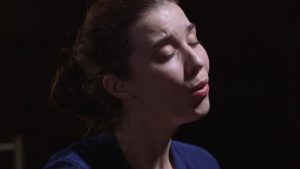Lisa Hannigan: Stalking the Muse
Description
After a decade of non-stop creativity, singer-songwriter Lisa Hannigan confronted and overcame the dreaded “blank page.”
Featured Artists

Lisa Hannigan is a celebrated singer and songwriter known for her whimsical folk-pop tunes, soft-spoken vocals, and quietly powerful lyrics.
Born in 1981 in Kilcloon, Ireland, Hannigan attended Trinity College Dublin. She left university after meeting musician Damien Rice, who invited her to tour as part of his band and to record on his internationally acclaimed debut album O (2002) and its 2006 followup, 9.
Hannigan parted with Rice in 2007 and released her first solo album, Sea Saw, in early 2008. A top 5 hit in Ireland, the record also charted in the UK and USA. Her subsequent studio albums, Passenger (2011) and At Swim (2016) both peaked at number 1 in the Irish charts and furthered her world-wide appeal. She is also known for her covers of other artists, many of which have appeared in TV and film.
As a voice artist, she performed in the fifth season of Cartoon Network series Steven Universe (2017–2019).
Transcript
Singer-songwriter Lisa Hannigan has been a touring solo artist since 2009. But she first came to public attention as a supporting singer to indie darling Damien Rice, whom she met in 2001 in Trinity College Dublin. She recorded, toured, and performed in his band for seven years. But her career as a singer began much earlier, in Ireland’s rural County Meath.
Lisa Hannigan: My very earliest memory is singing Joni Mitchell backing vocals in the back of the car, in the car seat with my brother, while my mother would be Joni Mitchell in the front. And we’d be in the back doing the “Ooh, bop, bop, bop” thing.
By 2011, Hannigan had barely stopped working for 10 years. Once she finally took a break after the tour for her second album, Passenger, writing was much more difficult than before. This happens to many artists. After a rush of output, a reckoning.
Hannigan: I sat down, and I made my tea, and I just found I didn’t know what to write about. And I felt sort of empty and kind of wrung out of emotion, I suppose. But I always thought, “I’m just going to get into the flow at some point, and lash out sort of six songs in a weekend,” and I never really got to that stage. But I asked everyone that I knew—all of the artistic, creative people that I knew—what to do in this situation, and everyone had been through it at some point.
AJC: The blank page?
Hannigan: Yeah. And everyone just said, “You just have to keep plowing on, and try and read great things, and read good poetry, and try and fill yourself up as much as possible, so that you do have some kind of well to draw from.”
The late Seamus Heaney, Ireland’s Nobel Prize-winning poet, gave Hannigan the creative jolt she’d been waiting for.
Hannigan: I have the beautiful set of all his Faber & Faber poetry books and I thought, “I’ll start at the beginning and work my way through again.” And when I got to “Anahorish,” which ended up on the record, it sort of looks like a song on the page. So I thought, I don’t know, I just started singing it instead of reading it, and I started off thinking, “This’ll be a good exercise to get me going into writing songs.” And actually, I loved it so much as it was that I just sort of put it on the record. And I asked Mary Heaney whether she would mind. That was okay, and his family were lovely and—
AJC: This was shortly after he died, right?
Hannigan: It was, yeah. It probably was in the year that he died that I started the re-reading of the books. And actually, the first time I ever performed it was at a tribute concert for him where Paul Simon was also there. His dressing room was sort of down the corridor and I would sort of creep by it excitedly during the day. And then we were in this tiny little box room, myself and the two people that I was singing with. So we were practicing over and over again—I’d never sung it in front of anyone before—and there’s this knock at the door. And I open the door, and it’s Paul Simon saying, “Hey, that sounds really nice. Mind if I sit in?” I said, “Sure, Paul Simon, come in. No, it’s fine.”
And so we sang it for Paul Simon in a space no bigger than between me and you. And so, every time I sing it since, I think of that. It helps me not be nervous. I think, “Do you remember when you had to sing in front of Paul Simon? He was right there. This is way easier than that.”
In addition to her repurposing of Heaney, Hannigan’s At Swim meditates on displacement, loss, mortality, and self-doubt. These darker songs reflect an artist a bit older, and a little wiser, but no less vulnerable for it.
Hannigan: The whole bloody business is an exercise in embarrassment. Yeah, it’s really embarrassing. The whole thing is “people looking up your skirt,” to use a Dublin phrase. But yeah, I do find it all very exposing and unnerving. And when you first play a song for somebody, there is that sense of scarlet, sheer internal sunburn. But, it sort of fades the more you play it, I find.

